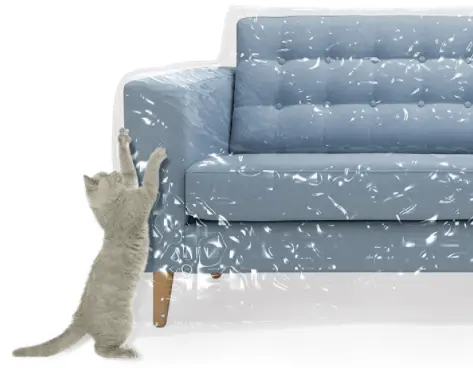Patio furniture offers great comfort and luxury of enjoying outdoor living. This is where you meet with your friends and family members to create memorable times. However, presence of cats in your home or neighborhood can throw all this into a disarray.

Cats are fond of scratching and spraying on objects as a way of having fun and marking their territory. Your outdoor garden furniture is not spared as long as the felines are freely roaming your backyard. A scratched patio couch is not only unsightly, but also money gone down the drain.
Replacing your torn outdoor cushions is not going to offer a solution to this, neither does punishing the cats. Besides keeping cats out of your yard, there are plenty of safe ways to keep cats off outdoor furniture without raising any trouble with Mother Nature.
How to Keep Cats off Outdoor Furniture
You save your patio furniture from cats through the following:
1. Natural Repellent Scents
Cats strongly utilizes their sense of smell and they can detect any mild scent, some which humans cannot. There are plenty of scents in nature that cats find unpleasant or too strong to bear. They include citrus, lavender, peppermint and cinnamon among others.
Some ingredients found in our garden or kitchen containing these type of scents include vinegar, lemons, oranges, bananas, limes and grapefruits. How do you use them? Extract the juice and mix with some water in a spray bottle then apply the solution around your patio furniture.
Many plants or flowers in our gardens also emit scents that are unwelcoming to felines. Cats will always avoid lavender, pennyroyal and scaredy cat plant. As a way of adding greenery to your patio or garden, these plants will also help you control the presence of cats in your yard.
You may also use safe commercial pet repellents that make use of odor scents that scare away pets. They come in form of spray or pellets. They portray the presence of a strong predator such as a lion. The product is simply applied in areas where you don’t want cats to appear and you will never see them there again.
Keeping stray cats away from your garden not only prevents them from peeing and pooping around, but also protecting your expensive patio couch from being torn apart. When using citrus solutions, do not soak your sofa or cushions as this will attract mold and mildew.
2. Pet Repellent Furniture Pad/Cover
Covering your outdoor furniture when not in use is a great way of protecting it from elements. While throwing a fabric cover on the sofa might keep it clean, it won’t teach your pets to stay away. Cats are notoriously cheeky and you will find them playing with the cover or taking some nap.
There are special less expensive furniture pads lined with a material similar to aluminum foil. Cats and dogs don’t like aluminum foil due to its rough sticky feel under paws, unpleasant sound and shiny appearance. Covering your furniture with aluminum is a pretty sure way of sending cats and dogs away.
3. Double-Sided Tape
Cats hate sticky materials especially on their paws. Attaching a double sided tape to furniture and areas that are likely to get scratched most will help in keeping cats away. While using this method, note that the tape can leave a residue on furniture which can be difficult to remove.
4. Pet Couch Protector
A good alternative to the tape is a pet couch pad. These are self-adhesive deterrent furniture protectors that can also be attached to the upholstery, doors, walls, mattress, car seat and other vulnerable areas. The protective pads are usually transparent, blends well with a surface and hard to notice.
To apply, simply peel off the self-adhesive pad and stick it where you want to protect. Depending with the type of the pad, you may secure it with twist pins. If there is need, you can cut it to sizes that you prefer. What amazes, couch protective pads can be removed easily without leaving any sticky residue or marks.
5. Ultrasonic Sound repellents
Installing a motion sensor ultrasonic sound device can help in keeping pets off your furniture. These are electronic devices that emits disturbing sounds only audible to cats or dogs. The device is placed strategically at the entry ways to the patio or patio. They have a motion sensor which triggers when any animal pass nearby.
A cheaper alternative to electronic sound gadget is the installation of sensitive bells or wind chines around your patio or garden. They can be triggered by wind or any small vibration thus producing annoying sound that will scare away cats from your furniture.
6. Cat Training
While this method may not apply to stray felines, you can train your own cat through verbal commands and incentives. Teaching or training a pet should begin early days in their lives. It may be difficult to train them when they are already used to a given habit. If you cannot handle yourself, you may hire the services from an expert.
7. Create Cat Zone
Just like we like lounging in garden, cats too feel good doing so. Setting up a cat zone with a nice pet couch, toys, a sand box and few catnip plants around can be attractive to your feline friend who will not find any interest cuddling in your sofa.
8. Inform the cat owner
Cats from your neighbor can be a nightmare to deal with. If they have converted your furniture into their territory, inform the owners about the problem. Stray cats without owners can be best dealt with by relevant animal authorities who can capture them and take them to a rescue center where they can be trained and get reunited with new families.
Conclusion
Protecting your outdoor furniture from pets and weather elements keeps them looking the best for years to come. Any of the above discussed tricks should help in keeping cats off your furniture for good.

